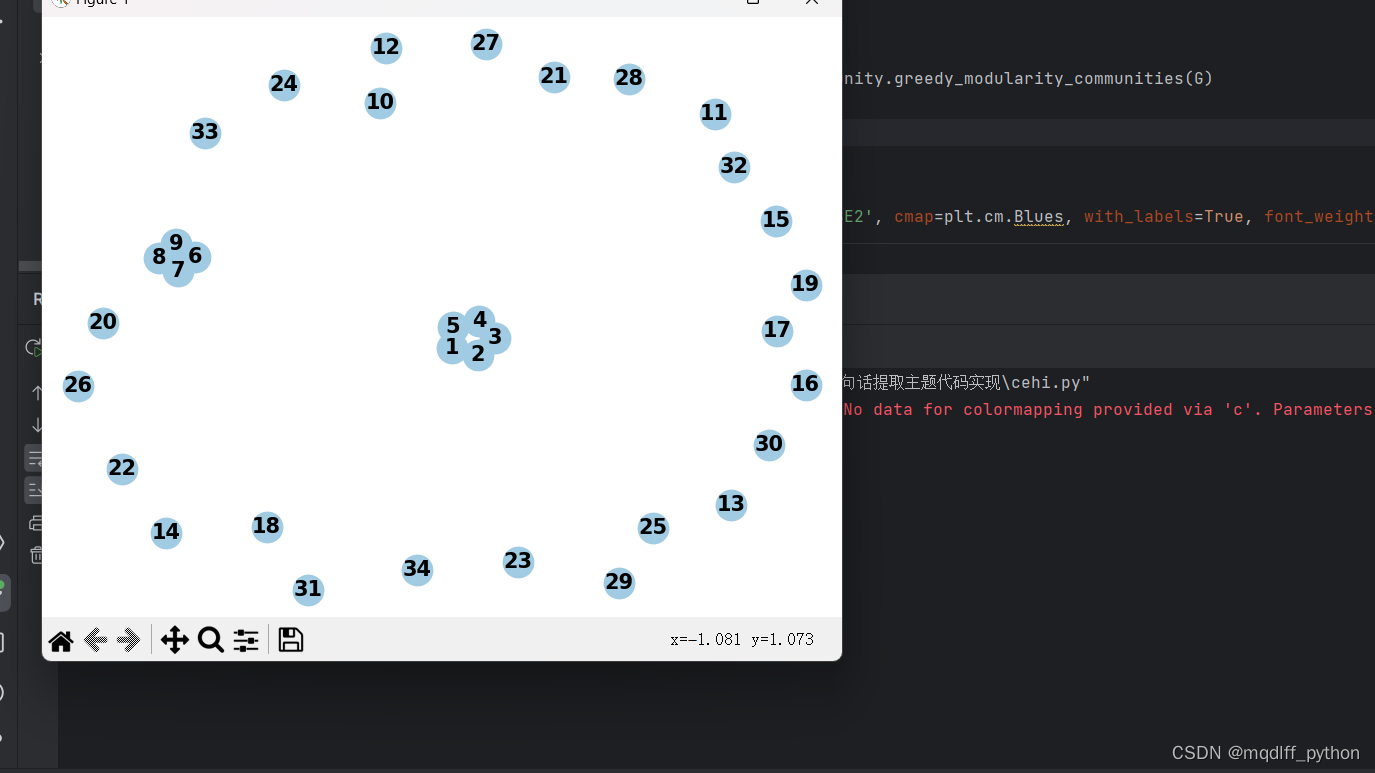某跆拳道俱乐部数据由34个节点组成,由于管理上的分歧,俱乐部要分解成两个社团。
发布时间:2024年01月24日
 ?
?
import networkx as nx
import matplotlib.pyplot as plt
# 创建一个图表示跆拳道俱乐部的网络
G = nx.Graph()
# 添加34个节点,表示俱乐部的成员或其他相关实体
nodes = list(range(1, 35))
G.add_nodes_from(nodes)
# 添加边表示成员之间的关系
# 这里仅是示例,你可能需要根据实际情况构建更具体的网络结构
# 比如通过读取俱乐部成员之间的连接关系数据
edges = [(1, 2), (2, 3), (3, 4), (4, 5), (5, 1), (6, 7), (7, 8), (8, 9), (9, 6)]
G.add_edges_from(edges)
# 使用 Louvain 方法进行社团发现
communities = nx.algorithms.community.greedy_modularity_communities(G)
# 将结果可视化
pos = nx.spring_layout(G)
colors = range(len(communities))
nx.draw(G, pos, node_color='#A0CBE2', cmap=plt.cm.Blues, with_labels=True, font_weight='bold')
plt.show()
# 输出社团划分结果
for i, community in enumerate(communities):
print(f"社团 {i + 1}: {list(community)}")
import networkx as nx
import matplotlib.pyplot as plt
# 创建一个图表示跆拳道俱乐部的网络
G = nx.Graph()
# 添加34个节点,表示俱乐部的成员或其他相关实体
nodes = list(range(1, 35))
G.add_nodes_from(nodes)
# 添加边表示成员之间的关系
# 这里仅是示例,你可能需要根据实际情况构建更具体的网络结构
# 比如通过读取俱乐部成员之间的连接关系数据
edges = [(1, 2), (2, 3), (3, 4), (4, 5), (5, 1), (6, 7), (7, 8), (8, 9), (9, 6)]
G.add_edges_from(edges)
# 使用 Louvain 方法进行社团发现
communities = nx.algorithms.community.greedy_modularity_communities(G)
# 将结果可视化
pos = nx.spring_layout(G)
colors = range(len(communities))
nx.draw(G, pos, node_color='#A0CBE2', cmap=plt.cm.Blues, with_labels=True, font_weight='bold')
plt.show()
# 输出社团划分结果
for i, community in enumerate(communities):
? ? print(f"社团 {i + 1}: {list(community)}")
?
文章来源:https://blog.csdn.net/mqdlff_python/article/details/135824341
本文来自互联网用户投稿,该文观点仅代表作者本人,不代表本站立场。本站仅提供信息存储空间服务,不拥有所有权,不承担相关法律责任。 如若内容造成侵权/违法违规/事实不符,请联系我的编程经验分享网邮箱:chenni525@qq.com进行投诉反馈,一经查实,立即删除!
本文来自互联网用户投稿,该文观点仅代表作者本人,不代表本站立场。本站仅提供信息存储空间服务,不拥有所有权,不承担相关法律责任。 如若内容造成侵权/违法违规/事实不符,请联系我的编程经验分享网邮箱:chenni525@qq.com进行投诉反馈,一经查实,立即删除!
最新文章
- Python教程
- 深入理解 MySQL 中的 HAVING 关键字和聚合函数
- Qt之QChar编码(1)
- MyBatis入门基础篇
- 用Python脚本实现FFmpeg批量转换
- MySQL(三)——函数
- 【力扣刷题练习】236. 二叉树的最近公共祖先
- 地质灾害形成机理与成灾模式,GIS在灾害危险性评价中的方法,GIS在灾后重建规划等领域的应用方法
- Leetcode的AC指南 —— 哈希法/双指针:15. 三数之和
- Corel Painter各版本安装指南
- 静态HTTP:构建高效、可扩展的Web应用程序的基础
- LaTeX系列1——主结构
- 【LeetCode】2648. 生成斐波那契数列
- debian 12 zabbix 6.0LTS部署
- Python接口自动化测试 —— unittest批量用例管理!